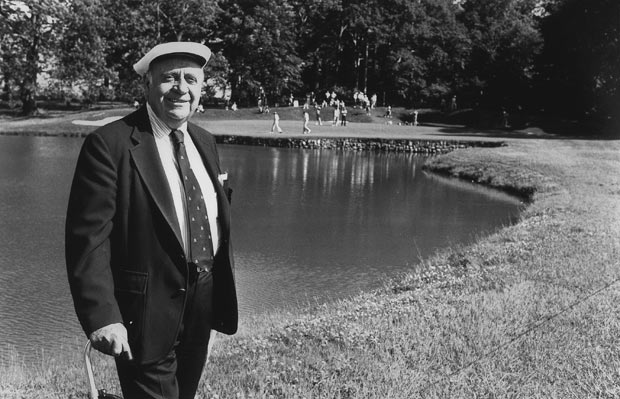
Robert Trent Jones moved to the U.S.A. with his parents in 1911. He proved to be an excellent golfer already in his teens. At sixteen he beat the record field in the Rochester Championships. Jones attended Cornell University, where he took a course specifically directed to the architecture of golf courses. At Cornell, he drew some courses for the Sodus Bay Golf Club in New York.
In the mid-'60s, Robert Trent Jones had become the best well known and perhaps the most influential golf course architect ever. He was a consultant for many courses where the major championships take place - and many of them were designed by himself. In 1990 he had to his credit more than 450 courses in operation in 42 states and 23 countries and had remodeled many others, travelling about 300,000 miles per year.
He published several works on golf courses architecture, including some contributions to The Complete Golfer, by Herbert Warren Wind (1954), Golf Its History, Events, and People, by Will Grimsley (1966), and Golf Courses Design, Construction and Upkeep, by Martin Sutton ( 2nd ed. 1950). The work of Sutton included several drawings of golf holes designed by Jones. In 1989 his long awaited autobiography, Golf Magnificent Challenge, co-authored by Larry Dennis, was published.
Robert Trent Jones was the first to receive the ASGCA's Donald Ross Prize for outstanding contribution to golf course architecture. He was appointed as adviser of the National Institute of Social Science, member of the American Academy of Achievement and received a silver tray in 1972, becoming a member of the Royal and Ancient Golf Club of St. Andrews. In 1981 Jones was awarded the GWAA’s William D. Richardson Award in recognition of his extraordinary contributions. That same year, the Metropolitan Golf Association grants him with the Distinguished Service Award. In 1987 GCSAA honored him with the Old Tom Morris Award.
In 1990 Trent Jones had already 60 years of experience in golf courses design, surpassing even Old Tom Morris himself. The name of Robert Trent Jones was then the most well known in the golf world and two courses were baptized after him, a new and an existing one (the Robert Trent Jones Course at Cornell). That same year the company closed the largest contract ever on golf courses design, a series of 54 holes in the daily fee system, for Sunbelt Golf, Inc., in Alabama, funded in part by the social security fund for the civil servants of the state. Today this complex is one of the most visited by golf players.